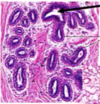Endo 2 (Pituitary) Flashcards
What are the areas of the pituitary?
Anterior
- adenohypophysis (true gland since it’s epithelial tissue)
- arises from an outgrowth of the ectoderm of the roof of the mouth
Posterior
-neurohypophysis (made up of neurons- terminal axons that start in hypothalamus called neurosecretory cells)

How do the anterior and posterior pituitary develop?
- ectoderm: embryonic layer that gives rise to CNS/PNS and integument
- mesenchyme: undifferentiated cells
- ectoderm: gives rise to roof of mouth
- pouches begin to form called neurohypophyseal bud and Rathke’s pouch (hypophyseal pouch)
- these buds come together and form anterior and posterior pituitary
- pars intermedia is tissue between them

Where is pituitary located?
- tuberculum sellae
- hypophyseal fossa
- dorsal sella
- together form the sella turcica where pituitary sits



Describe pituitary tumours
- mainly occur in adenohypophysis (neural tissue in neurohypophysis is postmitotic)
- can lead to compression of optic chiasm (can lead to diplopia)
- can be functional that release hormones or non functional that just take up space

How can pituitary tumours be removed?
- goes through nasal cavity and go through sphenoid bone to get to pituitary
- transsphenoidal hypophysectomy

When is blood flow to pituitary compromised? What happens?
- inferior and superior hypophyseal arteries are branches off of the internal carotid artery
- entire systemic BP has dropped dramatically (during labour and delivery, car accident)
- if it drops in superior/inferior hypophyseal artery there might not be enough pressure to push blood through to pituitary
- panhypopituitarism
- low pressure in capillaries so hard to keep enough pressure to keep blood moving to pituitary
Do posterior and anterior pituitary communicate?
- no
- derived from different tissues
What are the hormones of the posterior pituitary?
- oxytocin
- antidiuretic hormone
- both hydrophilic so they act on cell surface receptors
- peptide hormones, 9 amino acids in length
What does ADH do?
- tells kidney to reabsorb water so you don’t lose it (prevents diuresis)
- maintains hydration
- also known as vasopressin- high concentrations can directly stimulate smooth muscle of BVs to cause vasoconstriction
- released from supraoptic nucleus (right above optic chiasm) of the hypothalamus
- puts water permeable pores in the collecting duct of the kidney to bring in as much water as possible
When is ADH stimulated to release or inhibited?
- released in response to increased osmolarity of the blood (lots of salts and dissolved minerals in the blood but not a lot of water)
- low BP and low blood volume (kidneys will reabsorb water to maintain some of that blood volume)
- pain and certain drugs (pain- usually follows a cut or injuries where you might lose blood volume)
- inhibited by adequate or over hydration of the body and alcohol
How does alcohol affect ADH?
- alcohol inhibits release of ADH from hypothalamus
- causes inappropriate dehydration because it does not stop diuresis so you urinate more
How is oxytocin released?
- neurosecretory cell in paraventricular nucleus of the hypothalamus
- oxytocin made in cell body of hypothalamus
- neural signals stimulate release (stretch on cervix, suckling on breast) from the hypothalamus to the posterior pituitary
- released into blood stream
What are hormones of the anterior pituitary?
- TSH: released in response to TRH from hypothalamus
- FSH: stimulates development of follicles in ovaries, promotes sperm production in response to GnRH from hypothalamus
- LH: release casued by GnRH and leads to sex hormone production in the gonads
- ACTH: released by CRH in hypothalamus and causes cortisol release
*above are tropic hormones- turn on some other gland*
- hGH: somatotropin- turns up growth of body released in response to GHRH (inhibited by GHIH)
- prolactin: release caused by PRH and inhibited by PIH (not a tropic hormone)
- MSH: causes melanocytes to make melanin (not really sure why it’s here)
How is hGH released?
- GHRH produced in hypothalamus and travels through portal system to get to anterior pituitary to cause hGH release
- GHIH produced in hypothalamus also
- net effect of GHIH and GHRH determines how much GH will be released in the end









